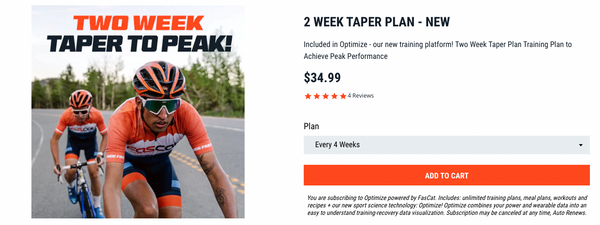Tapering in Cycling for Peak Performance
Frank Overton
Have you ever heard of the expression 'All the hay is in the barn?' To many cyclists and farmers alike it has great meaning: the hard work is over and now it is time to reap the benefits of a job well done.
To hit your absolute best form — to peak — cyclists reduce their training load and taper down. It's not complicated. After you have ramped up your training, culminating in a period of overload, you decrease your training volume while maintaining your intensity. In other words, you add more recovery days into your training, you keep your interval workouts on the calendar, but do fewer sets, say two sets of intervals instead of three.
What is a Peak?
A peak is when you are making your best power of the year and you feel absolutely fantastic. Mentally you are motivated to dig deep and your mind is fresh, motivated and looking forward to racing. You have more 'matches' to meet all the attacks, climbs and are able to dig deeper than perhaps you ever have (with the power output to show for it). During a peak, you'll get your best results and also set your Strava PR's.
What is a Taper?
Dr. Inigo Mujika is a renowned sports physiologist who has dedicated his career to studying tapering. He summarizes optimal tapering as the following:
- Minimize fatigue AND IMPROVE fitness via increased power output
- Maintain training intensity
- Reduce training volume by 60-90%
- Maintain training frequency at > 80%
- Individualize taper duration between 4 - 28 days
- Use progressive, nonlinear tapering designs
- Expect performance improvements of ~3% (range of 0.5% - 6%)
One to two weeks before your "A race" further fitness gains are unlikely, i.e. the barn is full - you've made the hay. The temptation to train more should be met with firm resistance. Instead, consider a well planned taper in your training plan design. By now you've done countless intervals in all lengths and amounts. You're in the best shape of your life and your ready to do whatever it takes to get that big result at the end of the season. But remember the hay--you put it in the barn and it was difficult. Now it's time to rest. Don't stop training, rather gradually decrease you training load by 60-90% each week leading up to your final rendezvous with the podium. Along with the decrease in load, increase your number of rest days.
Two-Week Taper to Peak Training Plan
Have you applied your overload? Then perhaps you're ready for the Two-Week Taper to Peak plan. Remember though, tapering without first doing an overload will not yield the results you want!
Taper Length & Training Plan Design
In my experience the length of your taper will depend on your age and the size of your build. Most cyclists will benefit from a two-week taper using Dr. Mujika's guidelines above. Since younger athletes in their twenties recover faster, they tend to peak after a 10-day taper. Older cyclists who recover slower might need a three-week taper. I have also found that multisport athletes because they train so much in three different sports benefit from a longer than shorter taper. Here is an example two-week taper:

In the second week truly all the hay is in the barn and rest is best. During the second week of a taper nearly all athletes start to get nervous that they aren't training. Welcome to the taper; second guessing is natural. Rest on this magnitude feel unnatural and sometimes its a little scary. However trust the design and all the extra rest will give your body the time it needs to 'supercompensate' and peak.
Summary:
*Mujika & Padilla, Med. Sci. Sports Exerc. 35:1182-1187, 2003
Copyright © 2023 FasCat Coaching. All rights reserved.
Download and join Optimize where Coaching is included, the training plans are unlimited and there's a 14 day trial to see for yourself! Message us what you are training for and we'll reply with the recommended plan(s)! FTP, race data, power-based training, or anything related to going fast on the bike is all fair game!
Five Things I Wish I Knew When I Was a Pro
The Most Important Cycling Workouts

Foundation : 3 Weeks
- Perfect for all cyclists beginning off season training
- Raise your CTL and the all-important muscle tension intervals

Phil Gaimon's FONDO
- Complete similar workouts to what Phil does to prepare for all his KOM's
- Sweet Spot training, threshold intervals, and some anaerobic work

Phil Gaimon's Strava PR Plan
- Perfect Plan for Those with Less Training Time, starts at 15 minutes per day
- VO2's, 1 minuters, Tabatas, threshold, suprathreshold, and even Sweet Spot

Road Race In-Season
- Weekend racing and group rides with weekday training and recovery
- anaerobic efforts like criss cross, Over/Unders Sweet Spot, Threshold

Road Racing Intervals
- Increase your functional and race-specific power output
- Includes Sweet Spot, VO2, Anaerobic, Threshold














































